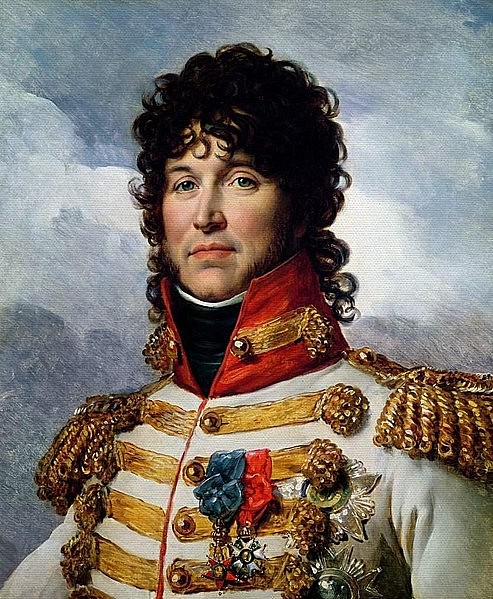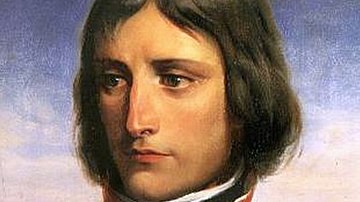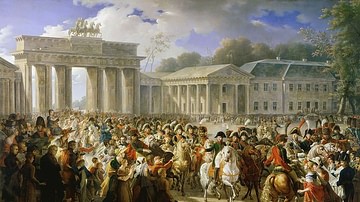
Joachim Murat (1767-1815) was a French cavalry officer who fought in the French Revolutionary Wars (1792-1802) and Napoleonic Wars (1803-1815). He was appointed marshal of the French Empire in 1804, Grand Duke of Berg in 1806, and ruled as King of Naples from 1808 until 1815. Through his marriage to Caroline Bonaparte, he was the brother-in-law of Napoleon I.
Early Life
The youngest of six surviving children, Joachim Murat was born in the village of La Bastide-Fortunière in Quercy, France on 25 March 1767. His father, Pierre Murat-Jordy, was a prosperous innkeeper and postmaster, who also served as a steward for the aristocratic Talleyrand family, the largest landowners in the region. With the help of his Talleyrand patrons, Pierre was able to procure a scholarship for his youngest son to pursue an ecclesiastical career. Young Joachim Murat did well enough to go on to the Seminary of the Lazarites in Toulouse, where he studied canon law in preparation to join the clergy. However, in February 1787, the 19-year-old Murat abruptly left the seminary. It is unclear exactly why. Some speculate that he was expelled for bad behavior, while others claim that he fell in love and ran away with a girl. Whatever the case, Murat soon ran out of money. Unsure of what to do next, he signed on with a cavalry regiment that happened to be passing through town. It was a fateful decision.
Tall, handsome, dandyish, and charismatic, albeit with a fiery temper, Murat adapted well to the life of a soldier and was soon promoted to sergeant-major. However, an incident in early 1789, the details of which are unknown, led to his temporary dismissal. He returned to his hometown just in time for the start of the French Revolution (1789-1799). Murat became swept up by the excitement of the Revolution and soon considered himself a zealous republican. He served a brief stint in his local National Guard before being reinstated in his old cavalry regiment. On 21 June 1791, King Louis XVI of France attempted to escape from the country in the Flight to Varennes but was caught and escorted back to Paris, partially by Murat's regiment. This opened the regiment to accusations of royalism, leading Murat to give a speech defending his regiment's conduct before an assembly at Toul.
In February 1792, Murat was selected to join the Constitutional Guard, a new royal bodyguard whose secret purpose was to prevent the king from making another escape attempt. Murat lasted only a month in the Guard before leaving, with some speculating his departure was to avoid disciplinary actions over his constant dueling. Perhaps hoping to cast off the royalist stain on his reputation, Murat claimed that he had been approached by an officer of the Guard with an offer to join a regiment of counter-revolutionary émigrés forming at Koblenz. The Legislative Assembly took the accusation seriously and used it as evidence to disband the Constitutional Guard later that year. Murat rejoined his old regiment and was promoted to full lieutenant in October. By this point, France had been declared a republic and the French Revolutionary Wars had begun.
Serving Napoleon
In January 1793, the trial and execution of Louis XVI caused Great Britain, Spain, and several other nations to join Austria and Prussia in the war against France. Murat did not see much combat during this stage of the war and was stationed with his regiment at Hesdin. He quarreled with his commanding officer, Colonel Landrieux, and the rivalry got so bad that Landrieux accused Murat of disloyalty to the Republic and of being an aristocrat. In the days of the Reign of Terror, this could have been a death sentence; however, Murat was able to prove that his father was not an aristocrat, bringing a halt to the investigation. To prove his loyalty, Murat briefly changed the spelling of his name to "Marat" to honor the martyred Jacobin leader Jean-Paul Marat. After the fall of Maximilien Robespierre in July 1794, Colonel Landrieux again tried to have Murat arrested by claiming that he had supported the Terror, showing as evidence that he had signed himself as "Marat" on documents. Murat was briefly arrested but set free due to lack of evidence.
Murat was then garrisoned in Paris with his regiment. He was still there on 4 October 1795, when 25,000 royalists rose in revolt against the Republican government. Defense of the city was entrusted to the young, Corsican-born General Napoleon Bonaparte (1769-1821), who ordered Murat to ride to the nearby military camp of Sablons and requisition 100 cannons; Napoleon authorized Murat to cut down anyone who stood in his way. Murat dutifully procured the guns that Bonaparte used to mow down hundreds of royalist insurrectionists, firing his famous 'whiff of grapeshot'. The royalist revolt of 13 Vendemiaire was crushed; though Napoleon failed to mention Murat's name in his official report, he nevertheless recognized the talent of the dashing cavalry officer.
In March 1796, Napoleon took command of the ragged French Army of Italy; Murat asked for a position on Napoleon's staff and became one of his aides-de-camp. Murat distinguished himself during the many battles of Napoleon's Italian Campaign and was awarded with the command of a brigade of dragoons. In 1798, Murat followed Napoleon to Egypt and commanded the cavalry of the French Armée d'Orient. He had little to do during the famous Battle of the Pyramids (21 July 1798), since the cavalry were sheltering within the infantry squares. Murat's shining moment would come a year later, during the Battle of Aboukir (25 July 1799). Exploiting a gap in the Turkish line, Murat led a daring cavalry charge that put the entire Ottoman army to rout. Murat's charge was so unexpected that he burst into the tent of the Ottoman commander, Seid Mustafa Pasha, and engaged him in single combat. In the duel, Murat was wounded in the mouth from a pistol shot but sliced off two of Mustafa's fingers. Mustafa was captured, and Murat was immediately operated on, resuming his duties the next day.

Napoleon was sufficiently impressed by Murat's valor; when he quietly slipped out of Egypt in August 1799, Napoleon chose Murat as one of the few officers to accompany him to Paris. On 19 October 1799, Murat's promotion to general of division was confirmed. Only days later, Napoleon seized control of the French government in the Coup of 18 Brumaire, in which Murat was an accomplice. Around this time, Murat was introduced to Napoleon's sister, Caroline Bonaparte, an intelligent and politically shrewd young woman, whom Charles-Maurice de Talleyrand once described as having "the head of Cromwell on the body of a pretty girl" (Pickles, 341). Murat vied for her hand with Jean Lannes, another of Napoleon's most talented officers; Murat won the contest but became lifelong rivals with Lannes. On 20 January 1800, the 32-year-old Murat married the 17-year-old Caroline in a civil ceremony. Later that year, Murat was appointed commander-in-chief of the Cavalry Reserve. He followed Napoleon across the Alps and fought the Austrians at the Battle of Marengo (14 June 1800).
Marshal of France
On 18 May 1804, Napoleon put the dying First French Republic out of its misery and proclaimed the First French Empire. That same day, Napoleon drew up a list of 18 'marshals of the empire', of whom Murat was the second man named. To add to the legitimacy of his new empire, Napoleon heaped various titles and honorifics upon his closest supporters, with Murat gaining the honorific of "Grand Admiral of the Empire". In this capacity, Murat led the grand procession that escorted the emperor to the Notre Dame of Paris during the Coronation of Napoleon I. As marshal of France and Napoleon's brother-in-law, Murat was one of the most influential men in the empire.
In 1805, the enemies of France gathered once again, declaring the War of the Third Coalition (1805-1806). As Napoleon personally led his new Grande Armée in a rapid march through Germany, Murat and the Cavalry Reserve rode ahead, mapping terrain and scouting for the enemy. The dashing cavalry officer played a major role in the Ulm Campaign, which resulted in the surrender of an entire Austrian army on 25 October 1805. Murat set off in pursuit of the nearby Russian army but changed course when he realized Vienna lay undefended. He and Lannes reached the key Tabor bridge over the Danube at the same time, and the two marshals put aside their personal rivalry to capture the bridge. They explained to the Austrian bridge commander that an armistice had been signed, tricking the Austrians into allowing the French to cross the bridge. By the time the officer realized he had been tricked, it was too late, and Murat entered the Austrian capital on 13 November. His cavalry played a major role in the subsequent Battle of Austerlitz, which knocked Austria out of the war.
The War of the Third Coalition was over by July 1806. The Holy Roman Empire was dissolved, as Napoleon asserted his dominance over Central Europe. Out of these new German territories, Napoleon created the Grand Duchy of Berg, which was awarded to Murat, who could now claim income from his new fiefdom. That autumn, Prussia joined with Russia against France in the War of the Fourth Coalition (1806-1807). The Prussians were decisively defeated at the double Battle of Jena-Auerstedt (14 October), though Murat turned the defeat into a complete rout by chasing the fleeing Prussian soldiers for miles and taking thousands of prisoners. In December, Murat was the first to enter Prussian-occupied Warsaw. He was greeted as a hero by the Poles and was presented with the sword of Stephen Báthory by Prince Józef Poniatowski. Relishing this warm welcome, Murat took up residence in Warsaw and encouraged the spread of rumors that he was about to be offered the crown of Poland. Ultimately, Napoleon granted control of the Grand Duchy of Warsaw to his ally, the King of Saxony.

After taking Warsaw, the Grande Armée continued to fight the Russians in Poland. The armies clashed at the Battle of Eylau (7-8 February 1807), a miserable and bloody engagement fought during a snowstorm. At one point, the Russians had gained the upper hand, but the day was saved when Murat led a brilliant cavalry charge that smashed through the Russian center; featuring over 11,000 horsemen, Murat's charge at Eylau is often considered one of the greatest cavalry charges in history. After the Battle of Friedland (14 June), the Russians capitulated, and peace was finalized with the Treaties of Tilsit.
King of Naples
After the Peace of Tilsit, Murat returned to Paris to bask in the extravagant lifestyle befitting a Grand Duke, but his ambitious wife, Caroline, was unsatisfied with her position as a Grand Duchess and sought to secure a kingdom for her husband. An opportunity for advancement would come in early 1808, as France became embroiled in the Peninsular War (1807-1814) with Spain and Portugal. Murat was named commander-in-chief of the French Army of Spain and was sent to occupy Madrid. On 2 May, Murat brutally suppressed the Dos de Mayo Uprising, organizing the executions of hundreds of Spanish insurrectionists. On 6 June 1808, Napoleon named his brother, Joseph Bonaparte, as King of Spain. Since Joseph had previously ruled the Kingdom of Naples, Napoleon needed a trusted subordinate to fill that vacancy and chose to install Murat, who took the regnal name of King Joachim-Napoleon I.
Napoleon expected Murat to act as a vassal king, to carry out all of the emperor's orders without question; Murat and Caroline, however, considered themselves to be merely allies of Napoleon, retaining the right to rule as they saw fit. As a price for the kingdom, Murat was forced to give up his estates within the French Empire and ended up losing some six million francs. Yet Murat was compensated by the love of his new subjects, who became enamored by their new king. Murat and Caroline's four children – two sons and two daughters – became princes and princesses of Naples, elevating the prestige of the House of Murat.

Shortly after taking the throne, Murat turned his attention toward Sicily, which was still held by the Bourbon King Ferdinand, the former ruler of Naples. Murat planned a grand invasion of Sicily, involving Neapolitan troops as well as French soldiers, but when the time came to invade, the commander of the French troops refused to cooperate, claiming he had received no orders from the emperor to do so. Without the support of the French troops, the invasion failed. Enraged, Murat apparently ripped the French Cross of the Legion of Honor from his breast and threw it across the room.
After Murat's failed invasion of Sicily, relations between the king of Naples and the French emperor began to cool. Murat failed to comply with Napoleon's large-scale embargo of the United Kingdom, known as the Continental System, and regularly turned a blind eye to smuggling in Naples. During a visit to Paris in 1811 to celebrate the birth of Napoleon's son, the emperor suggested to Murat that he may have to give up his throne for the solidarity of the empire. Asked to wait until the next day to discuss the matter, Murat left Paris immediately and rode back to Naples. Throughout all this, Murat was encouraged by Queen Caroline, who valued her status as a queen over loyalty to her brother.
Fall of Napoleon
In 1812, Murat arrived in Poland to take command of the cavalry of the Grande Armée in time for Napoleon's invasion of Russia. He marched with the 615,000-man army throughout the sweltering summer months and played a pivotal role in capturing the Russian redoubts during the bloody Battle of Borodino (7 September). Shortly after capturing Moscow, however, Napoleon was forced to withdraw, beginning his infamous retreat from Russia. By the time the Grande Armée recrossed the Niemen River on 5 December 1812, over half a million troops had been lost to disease, desertion, starvation, or battle; Napoleon gave Murat command of the frostbitten and malnourished survivors as he raced back to Paris to raise a new army.

Yet Murat did not stay in Poland much longer. Having received reports from his ministers that Queen Caroline was exceeding her authority, he rushed back to Naples on 18 January 1813. Napoleon was furious and ordered Murat to rejoin him, which the King of Naples did in August. However, after Napoleon's decisive defeat at the Battle of Leipzig (16-19 October), Murat realized that the French Empire was doomed; to save his own throne, Murat turned on Napoleon. He signed a deal with the Allies and joined the War of the Sixth Coalition in January 1814. Leading the 7th Allied army, he fought against Prince Eugène de Beauharnais, Napoleon's stepson, and his Franco-Italian force in northern Italy until news of Napoleon's abdication in April 1814.
Hundred Days & Downfall
After Napoleon's exile to Elba, it became obvious that the Allies did not care much for Murat. The British had never recognized Murat's rule of Naples and lobbied to restore the Bourbons. Murat tried to win British support by hiring English nurses for his children, drinking English port wine, and entertaining English guests including the Princess of Wales. However, when the Congress of Vienna was convened to decide the fate of a post-Napoleonic Europe, Naples was not invited. Noticing the writing on the wall, Murat began mobilizing his army, preparing to defend his throne to the death.
In March 1815, Napoleon shocked the world when he returned from exile to retake the French throne. Hoping to win the French emperor's forgiveness, Murat proclaimed himself to be an ally of Napoleon and declared war on Austria, sparking the Neapolitan War. However, on 2-3 May 1815, Murat's Neapolitan army was decisively defeated by the Austrians at the Battle of Tolentino. Murat knew that his throne was doomed, and on 18 May, he entered Naples to say goodbye to his family. Then, wearing a disguise, he left for France in a last-ditch effort to secure Napoleon's support. Shortly thereafter, the Austrians arrived in Naples and restored the Bourbon King Ferdinand to his throne; Ferdinand would combine the kingdoms of Naples and Sicily and rule as Ferdinand I of the Kingdom of the Two Sicilies.

Murat arrived in Toulon in late May. However, Napoleon would not even receive his treacherous brother-in-law. Murat remained in France until Napoleon's final downfall, at which point he sailed for Corsica with three friends. Murat plotted to regain his throne and, hoping to emulate Napoleon's triumphant return from Elba, landed in Calabria on 28 September with 28 soldiers and 2 servants. The Neapolitans were not so eager to receive their long-lost king; an angry mob gathered on the beach where he had landed and seized him before he could get back on his boat. He was imprisoned and sentenced to death, found guilty of trying to stage an insurrection in Naples. On 13 October 1815, Murat was executed by firing squad; he refused to wear a blindfold and his last words, spoken to the soldiers about to kill him, were, "If you wish to spare me, aim at the heart. Fire!" (Pickles, 351). His remains were buried in San Giorgio de Pizzo in Italy, while a cenotaph was raised in the Père Lachaise cemetery in Paris in his honor. His line, the House of Murat, persists to this day.







